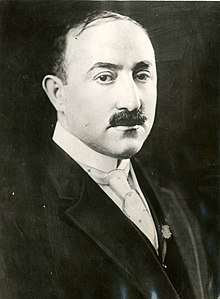William Fox (producer)
William Fox | |
|---|---|
 Fox in 1921 | |
| Born | Wilhelm Fried Fuchs January 1, 1879 |
| Died | May 8, 1952 (aged 73) New York City, U.S. |
| Resting place | Salem Fields Cemetery, Brooklyn |
| Occupation | Entrepreneur |
| Years active | 1900–1933 |
| Spouse |
Eva Leo (m. 1899) |
| Children | 2 |
Wilhelm Fried Fuchs (
Early life
Fox was born Wilhelm Fried Fuchs in
Film career
In 1900, Fox started his own company, which he sold in 1904 to purchase his first
In 1925–1926, Fox purchased the rights to the work of
Following the 1927 death of
Fox lost control of his organization in 1930 during a
For many years, Fox resented the way that Wall Street had forced him from control of his company. In 1933, he collaborated with the writer Upton Sinclair on a book Upton Sinclair Presents William Fox in which Fox recounted his life, and stating his views on what he considered to be a large Wall Street conspiracy against him.
Fox died in 1952 at the age of 73. His death went largely unnoticed by the film industry; no one from Hollywood attended his funeral. He is interred at
Fox personally oversaw the construction of many Fox Theatres in American cities including Atlanta, St Louis, Detroit, Portland, Oakland, San Francisco and San Diego.
His companies had an estimated value of $300,000,000 and he personally owned 53 percent of Fox Film and 93 percent of the Fox Theaters.[20]
Personal life
Fox was married to Eva Leo (1881–1962)[21] and had two daughters.
References
- OCLC 57459159.
- ^ "A 20th Century Foxot is magyar alapította". Népszabadság (in Hungarian). December 10, 2008. Archived from the original on April 4, 2010. Retrieved April 19, 2009.
- ISBN 978-0-7864-5763-2.
- ISBN 9780061136061.
- ^ OCLC 690102781.
- ^ "Twentieth Century Fox". Filmreference.com. Retrieved March 26, 2010.
- ^ OCLC 1002678502.)
{{cite book}}: CS1 maint: location missing publisher (link - )
- ISBN 978-0-7864-6286-5.
- ^ "William Fox".
- ^ ISBN 978-0-7864-6286-5.
- ^ "Progressive Silent Film List: A Fool There Was". www.silentera.com.
- ^ "Theda Bara (1885-1955)". Jewish Virtual Library. Retrieved April 21, 2021.
- ^ "The Vampire by Rudyard Kipling - Poems | Academy of American Poets".
- ^ Mitchell, J. Lawrence (2012). "Rudyard Kipling, The Vampire, and the Actress". English Literature in Transition, 1880-1920. 55 (3). ELT Press: 303–314.
- OCLC 179838406.
- Time Magazine. April 22, 1940. Archived from the originalon March 21, 2009. Retrieved August 9, 2008.
- ^ a b c d Eyman, Scott (December 8, 2017). "Review: William Fox, 'The Man Who Made the Movies'". Wall Street Journal. Retrieved April 22, 2021.
- ISSN 0362-4331. Retrieved January 18, 2020.
- OCLC 933438482.
- ^ "Ancestry.com". Ancestry.com.
Sources
- ISBN 0-385-26557-3.
External links
 Media related to William Fox (producer) at Wikimedia Commons
Media related to William Fox (producer) at Wikimedia Commons- William Fox at IMDb
- Historical Article on William Fox
- William Fox at Find a Grave
